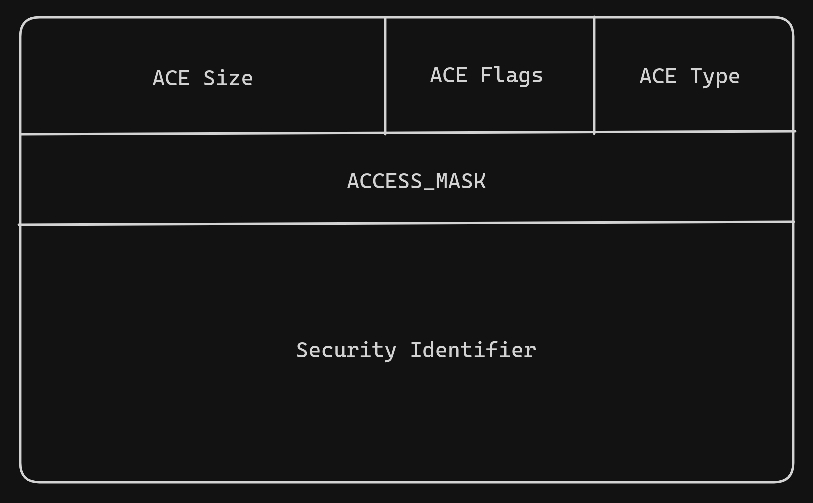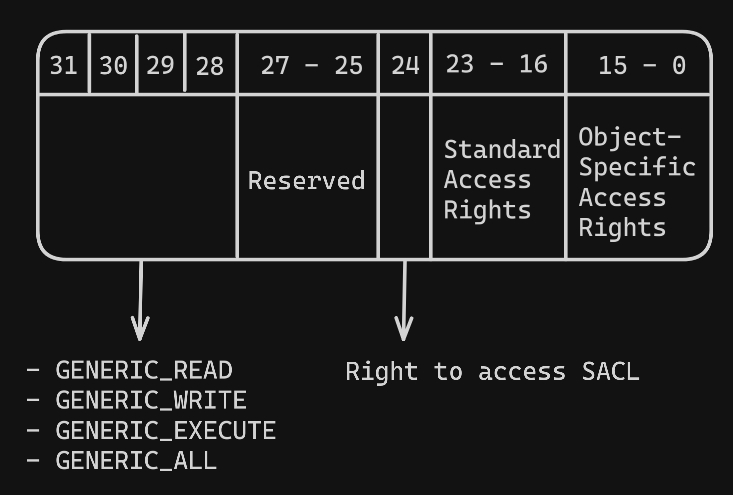DACL Overview
Within the Windows security ecosystem, tokens identify the security context of a process or a thread and security descriptors contain the security information associated with an object. To achieve Confidentiality, many operating systems and directory services utilize access control lists (ACLs): a mechanism that implements access control for a system resource by enumerating the system entities that are permitted to access the resource and stating, either implicitly or explicitly, the access modes granted to each entity.
Access control policies dictate what types of access are permitted, under what circumstances, and by whom. The four general categories of access control policies are:
DAC - Discretionary access control: controls access based on the requestor's identity and access rules stating what requestors are allowed to do. It is discretionary because an entity might have access rights that permit it, by its own volition, to enable another entity to access some resource
MAC - Mandatory access control: the entity having access to a resource may not, just by its own volition, enable another entity to access that resource
RBAC - Role-based access control
ABAC - Attribute-based access control
Windows is an example of a DAC operating system, which utilizes Discretionary access control lists or DACLs. witch are part of the bigger picture of security descriptors.
Security Descriptors
In Windows, every object (also known as securable objects) has a security descriptor data structure that specifies who can perform what actions on the object.
typedef struct _SECURITY_DESCRIPTOR {
BYTE Revision;
BYTE Sbz1;
SECURITY_DESCRIPTOR_CONTROL Control;
PSID Owner;
PSID Group;
PACL Sacl;
PACL Dacl;
} SECURITY_DESCRIPTOR, *PISECURITY_DESCRIPTOR;Only four of the seven members of the SECURITY_DESCRIPTOR struct matter to us for the exploitation of DACLs.
The security descriptor is a binary data structure that can contain six main fields:
Revision Number: the SRM (Security Reference Monitor) version of the security model used to create the descriptor
Control Flags: optional modifiers that define the behavior/characteristics of the security descriptor
Owner SID: the object's owner SID
Group SID: the object's primary group SID - only the Windows POSIX subsystem utilized this member (before being discontinued), and most AD environments now ignore it
Discretionary access control list: specifies who has what access to the object - throughout the
DACL Attacksmini-modules, our primary focus will be abusing and attacking theseSystem access control list or SACL: specifies which operations by which users should be logged in the security audit log and the explicit integrity level of an object
We are interested in the Control, Owner, Sacl and Dacl fields.
A security descriptor can be one of two forms:
absolute security descriptors: contain pointers to the information, as in the
SECURITY_DESCRIPTORstruct above, and these are the ones that we will encounter when interacting with Windows objects, whether AD ones or not
Self-relative security descriptors are not very different: instead of storing pointers, they store the actual data of a security descriptor in a contiguous memory block -these are meant to store a security descriptor on a disk or transmit it over the wire
Control Field
The Control member is of type SECURITY_DESCRIPTOR_CONTROL, a 16-bit set of bit flags that qualify the meaning of a security descriptor or its components. The value of Control, when retrieved with the function GetSecurityDescriptorControl, can include a combination of 13 bits flags:
0x0100
0x0400
0x0008
0x0004
0x1000
0x0002
0x0001
0x0200
0x0800
0x0008
0x0010
0x2000
0x8000
These binary flags can be added to represent any combinations - for example, if the value of Control is 0x8014, it signifies the presence of the SE_DACL_PRESENT, SE_SACL_PRESENT, and SE_SELF_RELATIVE flags.
Owner Field
The Owner and Group members contain a pointer to the Security Identifier of the object's owner and primary group, respectively. Object owners are always granted full control of the security descriptor, as they are granted the access rights RIGHT_WRITE_DAC (WriteDacl) and RIGHT_READ_CONTROL (ReadControl) implicitly.
SACL and DACL Fields
In Windows, SACL (System access control list) and DACL (Discretionary access control lists) are the two types of access control lists (ACLs), each consisting of a header and zero or more access control entries (ACEs). (Throughout security literature, when the term ACL is used, it usually refers to DACL, especially for Windows systems.)
A SACL contains ACEs that dictate the types of access attempts that generate audit records in the security event log of a domain controller; therefore, a SACL allows administrators to log access attempts to securable objects. There are two types of ACEs within a SACL, system audit ACEs and system audit-object ACEs.
While a DACL holds ACEs that dictate what principals have control rights over a specific object. Internally within Windows, a DACL consists of an ACL followed by an ordered list of zero or more ACEs (the same applies to SACLs). Below is the struct definition of an ACL (recognizing these struct definitions will help us later on when viewing a security descriptor from the kernel's point of view):
Generic and Object-specific ACEs
An ACE contains a set of user rights and a SID that identifies a principal for whom the rights are allowed, denied, or audited

In a DACL, there can be nine types of ACEs, each having the struct ACE_HEADER as a member, in addition to the Mask member (which is of type ACCESS_MASK and defines the standard, specific, and generic rights) and SidStart (which holds the first 32 bits of the trustee's SID):
but the most important are the following
Allows a particular security principal (user or group) to access an Active Directory object, such as a user account or group. An Access Allowed ACE specifies which permissions the security principal can perform on the object, such as read, write, or modify.
A specific type of Access Allowed ACE that is applied to an object and grants access to the object itself and any child objects it contains. An Access Allowed Object ACE can grant a security principal the necessary permissions to access an object and its child objects without applying separate ACEs to each child object.
Denies a particular security principal access to an Active Directory object, such as a user account or group. An Access Denied ACE specifies which permissions the security principal is not allowed to perform on the object, such as read, write, or modify.
A specific type of Access Denied ACE that is applied to an object and restricts access to the object itself and any child objects it contains. An Access Denied Object ACE prevents a security principal from accessing an object and its child objects without having to apply separate ACEs to each child object.
Some ACEs include the keyword Object, these are object-specific ACEs used only within Active Directory. In addition to the members of generic ACEs structure, object-specific ACEs contain the members:
ObjectType: AGUIDcontaining a type of child object, a property set or property, an extended right, or a validated writeInheritedObjectType: Specifies the type of child object that can inherit the ACEFlags: Indicates whether the membersObjectTypeandInheritedObjectTypeare present via a set of bit flags
Interpret Access Masks
We mentioned that all ACE data structures (such as ACCESS_ALLOWED_ACE) contain the Mask member, which is of type ACCESS_MASK: a 32-bit value that specifies the allowed or denied rights to manipulate an object

How do we interpret access masks and their bits?
Generic access rights bits
GenericAll
GA/RIGHT_GENERIC_ALL
0x10000000
Allows creating or deleting child objects, deleting a subtree, reading and writing properties, examining child objects and the object itself, adding and removing the object from the directory, and reading or writing with an extended right. This is equivalent to the object-specific access rights bits (DE | RC | WD | WO | CC | DC | DT | RP | WP | LC | LO | CR | VW) for AD objects.
GenericExecute
GX/RIGHT_GENERIC_EXECUTE
0x20000000
Allows reading permissions on and listing the contents of a container object. This is equivalent to the object-specific access rights bits (RC | LC) for AD objects.
GenericWrite
GW/RIGHT_GENERIC_WRITE
0x40000000
Allows reading permissions on this object, writing all the properties on this object, and performing all validated writes to this object. This is equivalent to the object-specific access rights bits (RC | WP | VW) for AD objects.
GenericRead
GR/RIGHT_GENERIC_READ
0x80000000
Allows reading permissions on this object, reading all the properties on this object, listing this object name when the parent container is listed, and listing the object's contents if it is a container. This is equivalent to the object-specific access rights bits (RC | LC | RP | LO) for AD objects.
Standard Access Rights Bits
WriteDacl
WD/RIGHT_WRITE_DAC
0x00040000
Allows modifying the object's security descriptor's discretionary access-control list (DACL).
WriteOwner
WO/RIGHT_WRITE_OWNER
0x00080000
Allows modifying the object's security descriptor's owner. A user can only take ownership of an object but cannot transfer ownership of an object to other users.
ReadControl
RC/RIGHT_READ_CONTROL
0x00020000
Allows reading the data from the object's security descriptor, however, this does not include the data of the SACL.
Delete
DE/RIGHT_DELETE
0x00010000
Allows deleting the object.
Object-specific Access Rights Bits
CR/RIGHT_DS_CONTROL_ACCESS
0x0000100
Allows performing an operation controlled by a control access right. The ObjectType member of an ACE can contain a GUID that identifies the control access right. If ObjectType does not contain a GUID, the ACE controls the right to perform all control access right controlled operations associated with the object. Also referred to as AllExtendedRights, especially when ObjectType does not contain a GUID.
WP/RIGHT_DS_WRITE_PROPERTY
0x00000020
Allows writing properties of the object. The ObjectType member of an ACE can contain a GUID that identifies a property set or an attribute. If ObjectType does not contain a GUID, the ACE controls the right to write all object's attributes.
VW/RIGHT_DS_WRITE_PROPERTY_EXTENDED
0x00000008
Allows performing an operation controlled by a validated write access right. The ObjectType member of an ACE can contain a GUID that identifies the validated write. If ObjectType does not contain a GUID, the ACE controls the rights to perform all validated write operations associated with the object. Also referred to as Self.
Extended (Object-specific) Access Rights
User-Force-Change-Password
00299570-246d-11d0-a768-00aa006e0529
Allows a user's account password to be reset without knowing the old one. This is in contrast to User-Change-Password, which does require knowing the old password.
DS-Replication-Get-Changes
1131f6aa-9c07-11d1-f79f-00c04fc2dcd2
Required to replicate changes from a given NC (Naming Context). To perform a DCSync attack, this extended right and DS-Replication-Get-Changes-All are required.
DS-Replication-Get-Changes-All
1131f6ad-9c07-11d1-f79f-00c04fc2dcd2
Allows the replication of secret domain data. To perform a DCSync attack, this extended right and DS-Replication-Get-Changes are required.
Validated Writes
Self-Membership
bf9679c0-0de6-11d0-a285-00aa003049e2
Allows editing the member attribute, therefore enabling setting membership of groups.
Validated-SPN
f3a64788-5306-11d1-a9c5-0000f80367c1
Allows editing the Service Principal Name (SPN) attribute.
Last updated